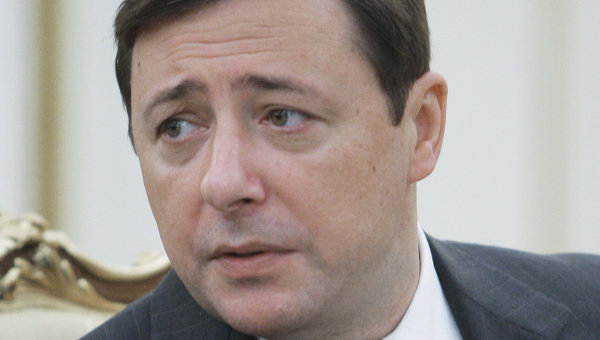
Kremlin Chooses Guns Over Butter Approach to Dealing with North Caucasus
Publication: Eurasia Daily Monitor Volume: 8 Issue: 220
By:

On November 23, Moscow’s envoy to the North Caucasus, Aleksandr Khloponin, officially confirmed earlier information that the planned large-scale program for economic development of the North Caucasus would not be approved by the end of 2011. Khloponin told a press conference in Makhachkala, Dagestan, that the program for the region’s economic development should be adopted in May 2012 (www.kavkaz-uzel.ru, November 24).
The news that the North Caucasus economic development program would not be approved stands in contrast to spending on the military in the North Caucasus. On November 21, President Dmitry Medvedev paid a surprise visit to Vladikavkaz, North Ossetia. The commander of the southern Russian military district, Lieutenant-General Aleksandr Galkin, reported to the head of state that latest generation arms comprised up to 70 percent of the total armaments in the military district. In comparison, only 10-20 percent of the Russian armed forces’ weapons are modernized or new. Special attention was paid to the rearmament of the 58th Army stationed in the North Caucasus and fighting the guerrillas in the region. Moscow plans to spend roughly $170 billion on the military in the North Caucasus by 2020. This is almost $40 billion more than what Moscow was planning to spend on the overhaul of the infrastructure and economic projects in the North Caucasus under the special federal program by 2025 (https://www.ng.ru/regions/2011-11-25/1_kavkaz.html, November 25).
In July 2011, the Russian government announced plans to invest up to $86 billion on North Caucasus economic development and attract another $47 billion in private investment. Even though government investment would amount to only about $6 billion per year over the life span of the program of 14 years, Russia’s finance ministry still decided it could not afford it. Were the program to be implemented, the average monthly salary in the North Caucasus after 14 years would increase from the current $330 to $770. The latter number is lower than even the current average wages in Russia (https://www.ng.ru/regions/2011-11-25/1_kavkaz.html, November 25).
It is ironic that spending on the military in the North Caucasus rivals spending on the economic development of the region. This clearly indicates where Moscow’s priorities lie, indicating that the North Caucasus is seen as a hostile territory that needs to be controlled through a heavy military presence.
Lieutenant General Galkin reported to President Medvedev that the 58th Army had been equipped with a digital communications system with video-conferencing capabilities. By the end of November 2011, the army would reportedly receive BTR-82A armored personnel carriers, upgraded T-72B tanks and the T-90A, Russia’s latest tank, as well as artillery and anti-aircraft systems. In the next few years, more attack helicopters and aircraft will be delivered to the Russian army detachments in the North Caucasus. Galkin stated that all Russian military units in the south of the country would be equipped with a unified system of control and the 58th Army would be the first to adopt this new system of armed forces management (https://www.ng.ru/regions/2011-11-25/1_kavkaz.html, November 25).
Such an eyebrow-raising Russian military build-up in the North Caucasus may have several explanations. Moscow might still have plans for further adventurism in the South Caucasus, including Georgia. The Russian government probably does not expect the situation in the North Caucasus to improve any time soon or to have enough money and political skill to develop the region, and therefore they are substituting the flexing of military muscles for development. The Winter Olympic Games in Sochi in 2014 may be another reason for the additional military build-up. Earlier in October, it transpired that a new 49th Russian Army was being set up in the northwestern part of the Caucasus (EDM, November 9).
By postponing the adoption of the federal program for North Caucasus economic development until May 2012 – i.e., well after the Russian presidential elections – Moscow is probably trying to conceal that it is completely abandoning the economic development of the region. In October-November 2011, the Russian government announced major breakthroughs in negotiations over attracting major foreign investors to tourism and infrastructure related projects in the North Caucasus, including Korea Western Power, CHT Korea, Suprema Associates (Singapore), Caisse des Depots et Consignations (France) (https://www.vedomosti.ru/realty/news/1423277/investor_iz_singapura_vlozhit_v_turisticheskij_klaster_na, November 16).
However, all these agreements are preliminary and contingent upon heavy government financial backing as well as the results of the 2012 presidential elections in Russia. It is unclear how major infrastructure projects will proceed in the extremely risky environment of the North Caucasus if they are not supported by the government. There is a high probability that Moscow is not looking much beyond the presidential election in March 2012 and is indulging in populist rhetoric about foreign investors, but not ready to substantiate these claims. Instead, Russia seems to be relying on the “tried-and-true” mechanism of controlling the North Caucasus by military means, in a manner increasingly reminiscent of Moscow’s colonial past.
On December 2, the Kavkazsky Uzel (Caucasian Knot) website reported that its open source data analysis indicated 683 people were killed and 522 were injured in the North Caucasus in the period of January-November 2011. It is noteworthy that the number of killed is greater than the number of injured, which may circumstantially point to a preference on the part of government forces to kill rebel suspects instead of arresting and trying them in courts. While Dagestan continued to register the greatest number of violent incidents, it is still surprising to see such relatively quiet regions as North Ossetia and Karachaevo-Cherkessia in the same list, with 16 and 15 people killed, respectively, and nine wounded in each republic (www.kavkaz-uzel.ru, December 2).
The new-old Russian approach to the North Caucasus promises a bleak future for the region, with increasing levels of violence and a further decline of local economies.




